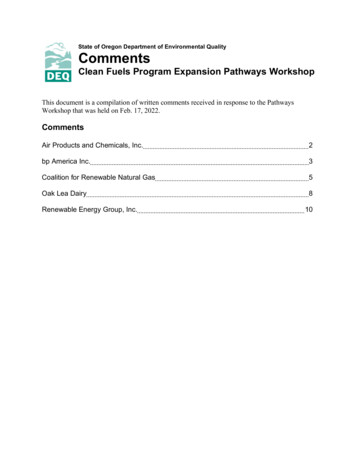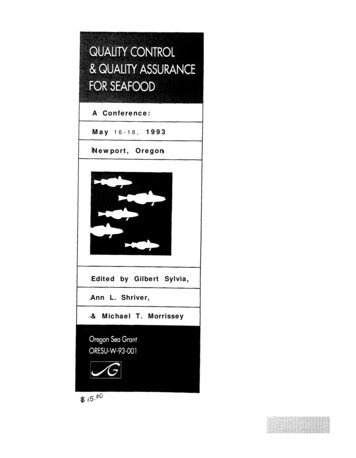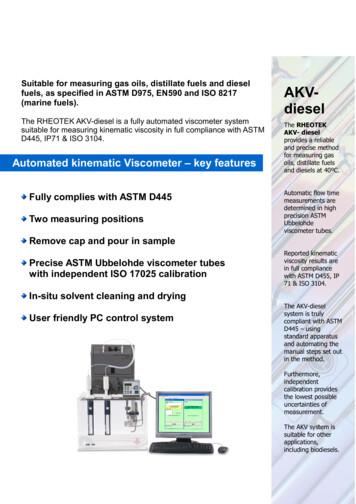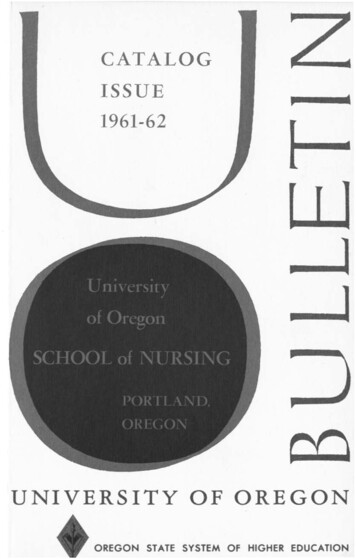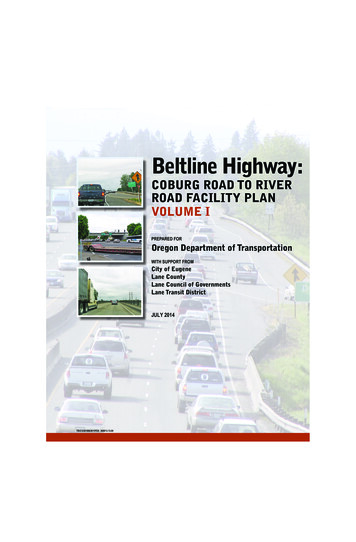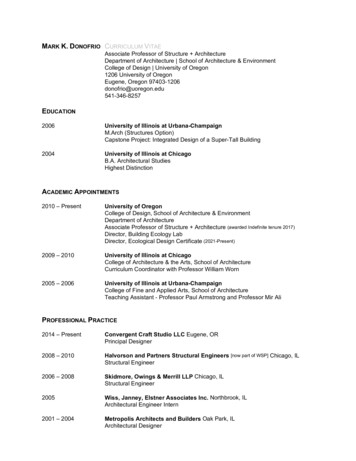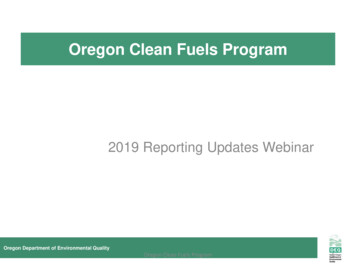
Transcription
Oregon Clean Fuels Program2019 Reporting Updates WebinarOregon Department of Environmental QualityOregon Clean Fuels Program1
Agenda Status update Changes to reporting for 2019 Q&ADue to the number of attendees, we will be takingquestions via the webinar’s chat box. We’ll try to answerclarifying questions as they come in, and will take theothers at the end.Oregon Clean Fuels Program2
Clean Fuel StandardsClean Fuels StandardsAverage Carbon Intensity(gCO2e/MJ)100High Carbon FuelsGenerate Deficits989694929088Low Carbon FuelsGenerate Credits86 20162017 2018 2019 Gasoline 2020 Diesel2021 2022 20232024 2025 Alternative JetOregon Clean Fuels Program3
Compliance Deadline in April Compliance is due for all regulated parties at the end ofApril upon the submission of the 2018 Annual Report– For importers of blendstocks, 2018 deficits must be retired– For large importers of finished fuels who did not comply withtheir 2016-2017 deficits upon the submission of the 2017annual report, deficits from 2016-2018 must be retired If regulated parties do not have enough credits tocomply, they can elect to participate in the CreditClearance Market, or use the small deficit carryover ifthey have credits for at least 95% of the deficits that aredueOregon Clean Fuels Program4
Credit Clearance Market The maximum credit price for the 2019 CreditClearance Market will be 206.20 per credit DEQ will issue a call for credits to be pledged into theCredit Clearance Market on April 2nd More information on the Credit Clearance Market canbe found 019.pdfOregon Clean Fuels Program5
Healthy Bank of Credits500,000450,000400,000350,000t Based on information submitted to the CFP Online System.Oregon Clean Fuels Program6
Total CreditsOregon Clean Fuels 7Jan-17Dec-16Nov-16# of Credits Transferred120,000100,00080,000 8060,000 6040,000 4020,000 200 0Avg. Price per Credit7Average Credit PriceCFP Credit Market 140 120 100
Electricity & Natural Gas Starting in 2019, all compressed natural gas reportingwill change from standard cubic feet to therms For electricity, remember that the fuel pathway codes(FPCs) will change annually– ORELC2018 — ORELC2019, and so on– lc.pdf For EV charging equipment, if the equipment is servedby a utility that has opted into a utility specific CI, youcan use their fuel pathway to report those KWhOregon Clean Fuels Program8
Reconciliation The 90-day reporting period is meant to facilitatecounterparties reconciling their transactions with eachother– The first 45 days should be used to upload data into the system– The second 45 days should be used to reconcile transactionswith counterparties DEQ appreciates the work reporting parties have put into reconcile with their counterparties, and remindsparties that have transactions with others to make surethey have reconciled them before submittingOregon Clean Fuels Program9
More Reconciliation The only transactions that we do not currently requirebe reconciled are sales at the rack by position holders Purchases at the rack do need to be reported in orderfor entities operating below the rack to report thosegallons as exports, going to an exempt user, or as notfor transportationAny clarifying questions?Oregon Clean Fuels Program10
Substitute Pathways The Clean Fuels Program includes regulated partiesthat operate above and below the rack Entities above the rack (position holders at terminals)have said that it would be difficult for them to pass onaccurate carbon intensity information for blendedfinished fuels to below the rack entities (jobbers, endusers) Many below the rack entities have used the importedB5 and E10 fuel pathway codes to reportOregon Clean Fuels Program11
Substitute Pathways Substitute fuel pathways are limited-use Fuel PathwayCodes (FPCs) that can be used when the specific carbonintensity information for a liquid fuel is not being passed on These pathways have been in place for Biodiesel, Ethanol,and Renewable Diesel The pathways can only be used for the following transactiontypes: sales or purchases without obligation, exports, loss ofinventory, not for transportation use, and exempt fuel useOregon Clean Fuels Program12
Substitute Pathways In-state biofuel CIs arefalling as a result of theProgram, and can beexpected to do so in thefuture70Imported E10 Ethanol CI65CI (gCO2e/MJ) The imported finished fuelFPCs (ORGAS002,ORULSD002) assumedrelatively high CI biofuelcomponentsAverage CI for in-state biofuels60Imported B5 Biodiesel CI55504540Q1 Q2 Q3 Q4 Q1 Q2 Q3 Q4 Q1 Q2 Q3Oregon Clean Fuels Program2016Ethanol20172018Biodiesel13
Substitute PathwaysDescriptionFPCCarbon IntensityORGAS0116For 2019: 96.59For 2020 and beyond:96.00Substitute CI for B5 Diesel. This pathway mayonly be used to report transactions that are salesor purchases without obligation, exports, loss ofinventory, not for transportation use, and exemptfuel useORULSD01165For 2019: 97.26For 2020 and beyond:96.71Substitute CI for B20 Diesel. This pathway mayonly be used to report transactions that are salesor purchases without obligation, exports, loss ofinventory, not for transportation use, and exemptfuel use.ORULSD01162084.45Substitute CI for E10 Gasoline. This pathwaymay only be used to report transactions that aresales or purchases without obligation, exports,loss of inventory, not for transportation use, andexempt fuel use.Oregon Clean Fuels Program14
Substitute Pathways Beginning with Q1 2019 reporting, in cases where theposition holder at an in-state rack does not provide thecarbon intensity information for the biofuel portion ofthat blend, the substitute pathways should be usedreport the purchase without obligation and anysubsequent transactions for those gallonsAny clarifying questions?Oregon Clean Fuels Program15
Reporting Exports Exports must be reported, and should be reported bythe entity who holds title to the fuel when it leaves thestate For fuels blended in-state where the FPC and carbonintensity of the biofuel has not been passed on, thesubstitute fuel pathway codes must be used For blends without CI information that are notrepresented by the new substitute pathways, exportsshould be broken out and reported using the purelookup table and substitute fuel pathway codesOregon Clean Fuels Program16
Reporting Exempt Volumes Exemptions generally are for the uses of a fuel, and can onlybe claimed when there is reasonable evidence that they aregoing into the listed exempt vehicle. All gallons should bepresumed to be covered until proven to go to an exempt user Beginning with the start of 2019 reporting, ‘corrections’ topast reports to add exempt fuel claims will not be allowed Dyed diesel is not exempt from the Clean Fuels Program Off-road vehicles are not exempt unless explicitly called outOregon Clean Fuels Program17
Reporting Exempt VolumesOAR 340-253-0250(2)(a)(A) Aircraft;(B) Racing activity vehicles defined in ORS 801.404;(C) Military tactical vehicles and tactical support equipment;(D) Locomotives;(E) Watercraft;(F) Motor vehicles registered as farm vehicles as provided in ORS805.300;(G) Farm tractors defined in ORS 801.265;(H) Implements of husbandry defined in ORS 801.310;(I) Motor trucks defined in ORS 801.355 if used primarily to transportlogs; and(J) Motor vehicles that meet all of the following conditions:(i) Not designed primarily to transport persons or property;(ii) Operated on highways only incidentally; and(iii) Used primarily for construction work.Oregon Clean Fuels Program18
Reporting Exempt Volumes Beginning with the Q3 2018 data release, DEQ beganpublishing the volumes of fuels claimed as exemptfrom the program DEQ is adding exempt-use specific transactions to theCFP Online System for the Q1 2019 reporting period– The three agricultural-related exemptions will be grouped, butall others will be on their own Beginning with 2019 reporting, each category ofexempt fuel must be reported separatelyOregon Clean Fuels Program19
Reporting Exempt Volumes Reporting parties claiming exempt uses of fuel need to retaindocumentation that the fuel is going into the motor vehicles in-0250(2)(a) Account-level data (ie, cardlock transactions for a customer)can be used, but fuel suppliers should take care to determine ifa customer has vehicles filling on that account which are notexempt For example, if ABC Farms has a card lock account that pullsfuel for tractors and farm vehicles, but also for the personal(without farm plates) vehicles of ABC Farm’s owners, gallonsgoing to the personal vehicles cannot be claimed as exempt DEQ will be conducting audits on this issue in the comingmonthsOregon Clean Fuels Program20
Reporting “Not for Transportation” “Not for Transportation” means:– The fuel is being combusted in a stationary application, such as homeheating oil being used in a furnace, or diesel being used in an electricgenerator. It specifically does not include dyed (or undyed) productsbeing sold to:– Transportation refrigeration units– Forklifts If you have a question about a specific use, please askAny clarifying questions?Oregon Clean Fuels Program21
Pathway Migration DEQ has updated the carbon intensity model it uses toassign carbon intensity scores to fuels Fuel producers will be applying for and receiving newFPCs for their products under the new model over thenext two years When a facility is granted a new FPC, the old FPC willremain active for one quarter to allow gallons instorage or transit to be transferred to the new FPCOregon Clean Fuels Program22
Pathway Migration For example, if biodiesel producer A has the existingFPC BIOD444 and in Q2 2019 is granted the new FPCBIOD555, both will be active during the Q2 reportingperiod. Reporting entities with gallons in storage or in transitfrom Q1 to Q2 under the BIOD444 can transfer thegallons to the new FPC by recording a “Loss ofInventory” transaction in BIOD444 and then a “Gain ofInventory” transaction in BIOD555Oregon Clean Fuels Program23
Pathway onBIOD444Loss of Inventory2,000Transferring gallonsto BIOD555BIOD555Gain of Inventory2,000Transferring gallonsfrom BIOD444 In this example, the two transactions ‘lose’ the inventory out ofthe BIOD444 fuel pathway code, and then ‘gain’ it into theBIOD555 pathway code We plan to post a crosswalk to our Fuel Pathway Codeswebpage as we begin approving OR-GREET 3.0 applicationsOregon Clean Fuels Program24
Questions?Ask away, or you can contact us at the following:Oregoncleanfuels@deq.state.or.usBill PetersPeters.bill@deq.state.or.us(503) 229-6901Oregon Clean Fuels Program25
CFP Credit Market Oregon Clean Fuels Program 7 0 20 40 60 80 100 120 140 0 20,000 40,000 60,000 80,000 100,000 . -The first 45 days should be used to upload data into the system . Oregon Clean Fuels Program 13 40 45 50 55 60 65 70 Q1 Q2 Q3 Q4 Q1 Q2 Q3 Q4 Q1 Q2 Q3 2016 2017 2018 J)
